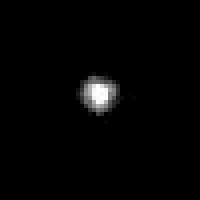
Back 20000 Varuna Afrikaans 20000 فارونا Arabic 20000 فارونا (كويكب) ARZ (20000) Варуна Byelorussian Варуна (транснэптунавы аб’ект) BE-X-OLD 20000 Варуна Bulgarian ২০০০০ বরুণ Bengali/Bangla (20000) Varuna Catalan (20000) Варуна CE Varuna (planetka) Czech
 Hubble Space Telescope image of Varuna, taken in 2005 | |
| Discovery[1] | |
|---|---|
| Discovered by | Spacewatch (Robert McMillan) |
| Discovery date | 28 November 2000 |
| Designations | |
| (20000) Varuna | |
| Pronunciation | /ˈværənə/ VARR-ə-nə[2] |
Named after | Varuna |
| 2000 WR106 | |
| TNO · cubewano[3] Scat-Ext[4] | |
| Adjectives | Varunian /vəˈruːniən/[5] |
| Symbol | |
| Orbital characteristics[1] | |
| Epoch 31 May 2020 (JD 2459000.5) | |
| Uncertainty parameter 2 | |
| Observation arc | 64.49 yr (23,555 days) |
| Earliest precovery date | 24 November 1954 |
| Aphelion | 45.117 AU (6.7494 Tm) |
| Perihelion | 40.319 AU (6.0316 Tm) |
| 42.718 AU (6.3905 Tm) | |
| Eccentricity | 0.05617 |
| 279.21 yr (101,980 d) | |
Average orbital speed | 4.53 km/s |
| 119.121° | |
| 0° 0m 12.708s / day | |
| Inclination | 17.221° |
| 97.372° | |
| 262.220° | |
| Neptune MOID | 12.040 AU (1.8012 Tm)[6] |
| Physical characteristics | |
Mean diameter | 654+154 −102 km[7] 668+154 −86 km[8] |
| 6.343572±0.000006 h[9] | |
| 0.127+0.04 −0.042[8] | |
| IR (moderately red)[10] B−V=0.88±0.02[11][12] V−R=0.62±0.01[11] V−I=1.24±0.01[11] | |
| 20.3 (opposition)[13][14] | |
| 3.760±0.035,[8] 3.6[1] | |
20000 Varuna[a] (provisional designation 2000 WR106) is a large trans-Neptunian object in the Kuiper belt. It was discovered in November 2000 by American astronomer Robert McMillan during a Spacewatch survey at the Kitt Peak National Observatory. It is named after the Hindu deity Varuna, one of the oldest deities mentioned in the Vedic texts.
Varuna's light curve is compatible with the body being a Jacobi ellipsoid, suggesting that it has an elongated shape due to its rapid rotation. Varuna's surface is moderately red in color due to the presence of complex organic compounds on its surface. Water ice is also present on its surface, and is thought to have been exposed by past collisions which may have also caused Varuna's rapid rotation. Although no natural satellites have been found or directly imaged around Varuna, analysis of variations in its light curve in 2019 suggests the presence of a possible satellite orbiting closely around Varuna.
- ^ a b c Cite error: The named reference
jpldatawas invoked but never defined (see the help page). - ^ Cite error: The named reference
pronouncedwas invoked but never defined (see the help page). - ^ Cite error: The named reference
MPEC2009-P26was invoked but never defined (see the help page). - ^ Cite error: The named reference
Buiewas invoked but never defined (see the help page). - ^ Duchesne-Guillemin (1958) The Western response to Zoroaster
- ^ Cite error: The named reference
MPCwas invoked but never defined (see the help page). - ^ Cite error: The named reference
Lellouch2019was invoked but never defined (see the help page). - ^ a b c Cite error: The named reference
TNOsCool9was invoked but never defined (see the help page). - ^ Cite error: The named reference
Valenzuela2019was invoked but never defined (see the help page). - ^ Cite error: The named reference
Mommert2013was invoked but never defined (see the help page). - ^ a b c Cite error: The named reference
Belskaya2015was invoked but never defined (see the help page). - ^ Cite error: The named reference
lcdbwas invoked but never defined (see the help page). - ^ Cite error: The named reference
Horizonswas invoked but never defined (see the help page). - ^ Cite error: The named reference
AstDyswas invoked but never defined (see the help page).
Cite error: There are <ref group=lower-alpha> tags or {{efn}} templates on this page, but the references will not show without a {{reflist|group=lower-alpha}} template or {{notelist}} template (see the help page).
© MMXXIII Rich X Search. We shall prevail. All rights reserved. Rich X Search